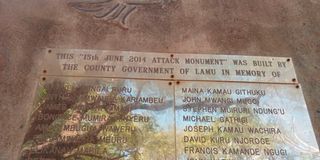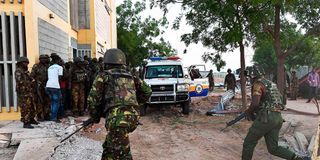
Kenya National Private Security Workers Union secretary general Isaac Andabwa laying flowers at Westgate Mall in Nairobi on September 21,2023 during the 10th anniversary of the terror attack at the mall.
| Evans Habil I Nation Media GroupNews
Premium
700 and counting: Lives lost in Kenya terror attacks after Westgate horror
At least 650 Kenyans have died in terror attacks in the country since the Westgate Mall attack in 2013, data compiled by Nation’s Research Desk shows.
Following the terror attack, then President Uhuru Kenyatta formed a joint committee of National Security and Defence and Foreign Relations to inquire into the Westgate Terrorist Attack, and resolved to, among many other things: Establish a National Counter-Terrorism Centre (NCTC) as a statutory body under the Office of the President, with a mandate to coordinate and oversee all counter-terrorism efforts in the country.

Then Tourism Principal Secretary Ibrahim Mohamed and Wahome Muchiri Chairman of the Committee on rapid restoration of Westgate shopping mall addressing the media at their offices at Teleposta towers on January 7, 2014.
The report of the joint committee urged Kenya's government to 'declare war against Al-Shabaab wherever they are', repeal the Refugee Act (2006), and close the Dadaab and Kakuma refugee camps and repatriate their residents.
The report faced criticism from some civil society groups, human rights activists, and legal experts, who argued that declaring war on Al-Shabaab would violate international law, escalate the conflict, and endanger the lives of Kenyan soldiers and civilians.
They also warned that closing the refugee camps and forcing the refugees to return to Somalia would violate their rights and expose them to further harm.
The report of the Joint Committee was NOT adopted by the Kenyan parliament, and the government did not declare war on Al-Shabaab.
A breakdown into timeline of attacks
Ten years later, terror attacks have continued to claim lives across the country.
The Westgate Mall siege, an event etched into Kenya's collective memory, remains the ominous overture to a decade of horror. On that fateful day, 68 innocent lives were extinguished when gunmen stormed the upscale shopping center in Nairobi.

A man sits on rubble during a tour, on January 21, 2014, of the destroyed Westgate mall in Nairobi by members of the court and four suspects of the massacre where at least 67 people were killed. The 2013 September attack was claimed by Somalia's Al-Qaeda-linked Sh a severely damaged part ebab insurgents. The trial opened on January 15, 2014. The four accused have all pleaded not guilty to charges of supporting a terrorist group.
The world watched in shock and horror as the Westgate tragedy unfolded, signaling the beginning of a menacing period of terror that would haunt Kenya for years.
June 2014 saw the devastating Mpeketoni attack, claiming 53 lives. July of the same year brought the horrifying Lamu and Tana River County Attacks, resulting in the loss of 29 lives.

The monument at Uhuru Park Grounds in Mpeketoni, Lamu West. Names of those killed during the deadly Mpeketoni attack on the night of June 15th, 2014 are clearly inscribed on the monument.
The Mandera bus attack in November 2014 claimed the lives of 28 people, foreshadowing the relentless violence that would follow.
In July 2015, the Quarry attack in Mandera County left 14 sleeping quarry workers dead, and just a few months later, the Kogelo bus attack in November 2015 left 28 individuals dead.
However, the darkest chapter in Kenya's recent history unfolded in April 2015 when 148 lives were snuffed out in the Garissa University College massacre.

Then President Uhuru Kenyatta and Deputy President William Ruto at a memorial monument erected by the Garissa County Government in honour of students of Garissa University College who lost their lives during a terror attack on the institution.
This gruesome act of violence sent shockwaves not only through Kenya but reverberated globally, spotlighting the urgent need for a united front against Al-Shabaab.
The year 2016 began with a chilling attack on Kenyan soldiers in El-Adde, Gedo, Somalia. The exact casualty figures remain disputed, but it is estimated that over 180 Kenyan troops perished.

Kenyan Defence Forces run towards the Garissa University campus after an attack by Somalia's Al-Qaeda-linked Shebab gunmen in Garissa on April 2, 2015. At least 70 students were massacred when Somalia's Shebab Islamist group attacked a Kenyan university today, the interior minister said, the deadliest attack in the country since US embassy bombings in 1998.
Kenya's agony continued with the October 2016 guest house attack in Mandera County, resulting in 12 fatalities. The Battle of Kulbiyow in January 2017 saw 67 Kenyan soldiers lay down their lives for their country.
In May 2017, two separate roadside bombings in Eastern Kenya claimed the lives of eight Kenyan officers, while the Wajir Primary School attack in February 2018 led to the loss of three Christian teachers.
The new year brought no respite, as the DusitD2 hotel complex attack in January 2019 claimed 21 lives and left 28 others injured. In April 2019, a brazen attack in Mandera town resulted in the death of a police officer and the abduction of two Cuban doctors.
Subsequently, a June 2019 IED attack in Wajir County led to the deaths of 11 police officers and the abduction of three Kenya Police Reservists.
The beginning of 2020 brought another blow, as Camp Simba at Manda Bay became the target of a devastating assault on January 5. In this audacious attack, three American soldiers lost their lives, serving as a stark reminder that terrorism knows no borders.
Just eight days later, on January 13th, the peaceful village of Kamuthe in Garissa County witnessed a horrifying incident that claimed the lives of three non-local teachers.
As the months rolled on, Kenya continued to grapple with these threats. On September 21, 2020, an attack on a Kenyan Defense Forces (KDF) convoy in Mandera County resulted in the loss of one KDF soldier.
July 8, 2020, marked yet another tragic day when al-Shabaab militants attacked a bus in Mandera County, claiming four lives. The year 2020 witnessed another grievous incident on October 6th when a highway bus in Mandera County was targeted, injuring seven civilians.
The year 2023 dawned with heart-wrenching incidents that shook the nation.
In Mandera County, on June 2023, an attack claimed the lives of nine individuals and left 24 others injured. Wajir County bore witness to an attack that left three individuals injured, while Lamu County experienced another devastating incident on June 13, 2023, resulting in the loss of eight lives.
Just five days later, the tranquility of Mlima Faru in Lamu County was shattered by twin attacks that claimed the lives of two KDF soldiers.





